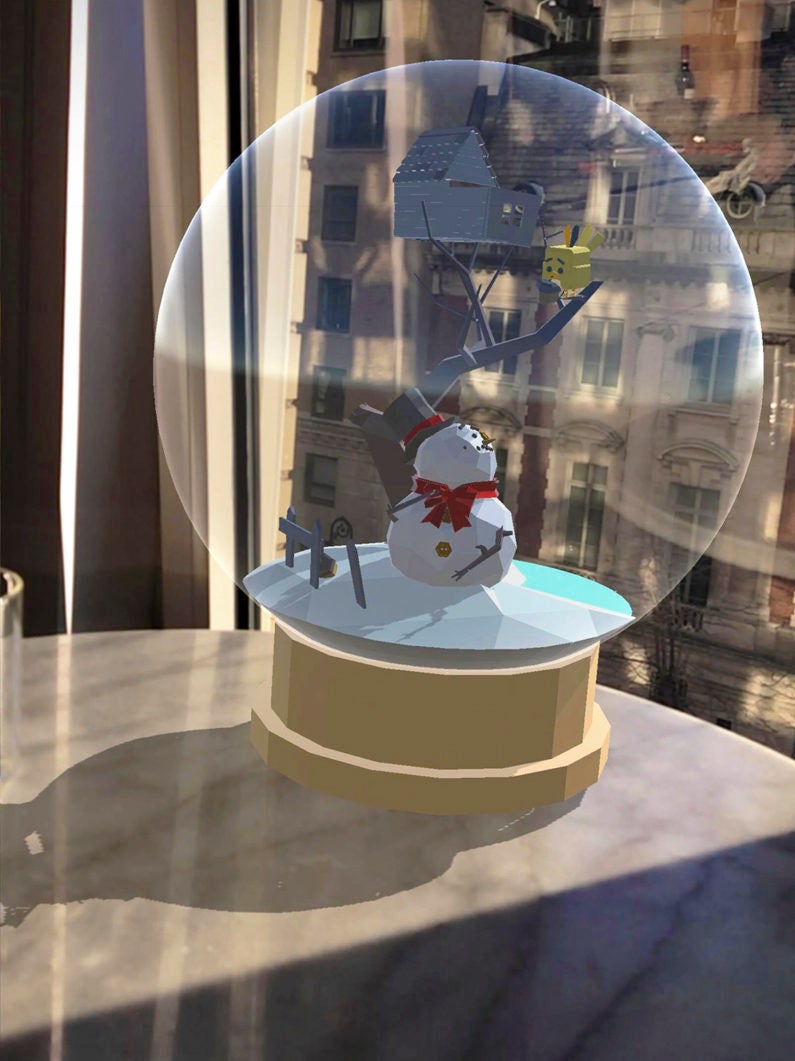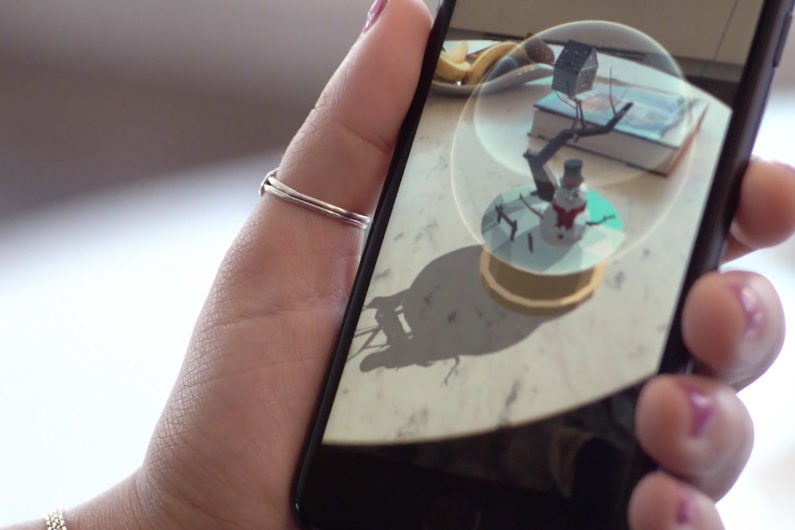Stanford senior and university VR club co-founder creates pioneering augmented reality film with fellow undergraduate
Max Korman believes that new augmented reality platforms represent a paradigm shift in how people will tell stories and create art in the future.
Stanford undergraduates Max Korman, ’18, and Khoi Le, ’20, launched what may be the world’s first augmented reality narrative film. And they did it using their mobile phones.

Snowbird is a 3D-animated short movie about porcelain creatures that come to life in a snow globe. (Image credit: Courtesy of Max Korman)
Augmented reality (AR) is a technology that presents virtual content in real world environments. Korman and Le’s film Snowbird harnessed this exciting new medium.
Snowbird is a 3D-animated short movie about porcelain creatures that come to life in a snow globe. Viewers can place a snow globe into their surroundings at any time – which could be at work, or home, during their commute or on May 12 at Stanford’s first annual VR for Everyone conference.
VR for Everyone is hosted by Rabbit Hole, Stanford’s virtual reality club co-founded in 2015 by Korman with an objective to foster community among immersive reality enthusiasts. The conference is expected to attract hundreds of attendees from campus and community. As reflected in the event’s name, VR for Everyone, adoption and inclusion in the industry are key themes.
The conference will also be the first public screening of Snowbird.
“We wanted to make a story that showcased what AR is great at right now, which is placing virtual objects on real world surfaces. Eventually, we settled on a story set in a snow globe, inspired by theater-in-the-round performance.”
—Max Korman, ’18
Founder, Rabbit Hole
“This project was absurdly fun and incredibly interesting to work on,” said Korman, who made use of a new package for developers that maps mobile device surroundings into 3D space in real time. Unlike the immersive experience of virtual reality, augmented reality superimposes images into a user’s view of the real world.
“We wanted to make a story that showcased what AR is great at right now, which is placing virtual objects on real world surfaces. Eventually, we settled on a story set in a snow globe, inspired by theater-in-the-round performance,” Korman said.
“In creating Snowbird, we explored many user journeys,” said Le, an award-winning hacker and self-described “virtual reality dreamer,” about the filmmaking process. “The user experience of mobile AR is novel, and weaving story elements into the process required creative approaches. For example, a user has to move their phone to scan the surroundings. By spatializing virtual snowfall, we encouraged users to turn their phones to look around and up at the falling snow, a natural reaction to seeing snowflakes falling around you,” Le said.
Viewers can also experience the film by simply downloading the Snowbird app.
“I think that AR will fundamentally change how people work and learn, but also experience art and stories,” Korman said. “The premise of immersive technology is the ability for creators to completely curate a person’s visual and auditory experience. So, I think it has the potential to transform any activity that relies on these senses.”

Viewers can use their phones to project the augmented reality film on their surroundings. (Image credit: Courtesy of Max Korman)
Korman and Le are already assessing different narrative premises for new AR films even without a clear distribution pipeline.
They are among the first to tap into the new energy from this emerging field.
Korman is a YoungArts National Winner and studied drawing and painting in high school at the Oxbow School in Napa, California. He considered going to an art school for college but chose Stanford because he believed in the university’s ability to foster innovation at the intersection of the arts and technology – two of his key interests.
“At Stanford I was fortunate to have immediately encountered VR during my freshman fall quarter through the Virtual Human Interaction Lab,” said Korman, referring to his experiences at the lab founded by Jeremy Bailenson, a communication professor in the Stanford School of Humanities and Sciences.
During his freshman year at Stanford, Korman also took advantage of a vibrant improv scene on campus. “I have grown so much as a storyteller through improv at Stanford. With the Stanford Improvisors [the student group that studies, trains and performs improvisational games and theater], I have effectively co-written, co-starred and co-edited literally hundreds of scenes and stories. Improv is great because you can get feedback on your artistic decisions from an audience in real time. The skills I learn in improv are at the core of every other storytelling project I work on.”
Korman, who is set to graduate in June with an individually designed major in engineering, wants to continue solving storytelling and design problems in the immersive technology space. Le, who still has a couple of years at Stanford, similarly plans to use immersive design and engineering principles to augment art, education and gaming.
